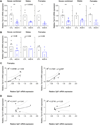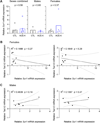Early-life influences of low-calorie sweetener consumption on sugar taste
- PMID: 36801464
- PMCID: PMC11062773
- DOI: 10.1016/j.physbeh.2023.114133
Early-life influences of low-calorie sweetener consumption on sugar taste
Abstract
Children and adolescents are the highest consumers of added sugars, particularly from sugar-sweetened beverages (SSB). Regular consumption of SSB early in life induces a variety of negative consequences on health that can last into adulthood. Low-calorie sweeteners (LCS) are increasingly used as an alternative to added sugars because they provide a sweet sensation without adding calories to the diet. However, the long-term effects of early-life consumption of LCS are not well understood. Considering LCS engage at least one of the same taste receptors as sugars and potentially modulate cellular mechanisms of glucose transport and metabolism, it is especially important to understand how early-life LCS consumption impacts intake of and regulatory responses to caloric sugars. In our recent study, we found that habitual intake of LCS during the juvenile-adolescence period significantly changed how rats responded to sugar later in life. Here, we review evidence that LCS and sugars are sensed via common and distinct gustatory pathways, and then discuss the implications this has for shaping sugar-associated appetitive, consummatory, and physiological responses. Ultimately, the review highlights the diverse gaps in knowledge that will be necessary to fill to understand the consequences of regular LCS consumption during important phases of development.
Keywords: Adolescence; Artificial sweetener; Cephalic phase; Glucose metabolism; Gustatory; Ingestive behavior; Sugar consumption; Sweet.
Copyright © 2023 Elsevier Inc. All rights reserved.
Figures





Similar articles
-
Early Life Low-Calorie Sweetener Consumption Impacts Energy Balance during Adulthood.Nutrients. 2022 Nov 8;14(22):4709. doi: 10.3390/nu14224709. Nutrients. 2022. PMID: 36432396 Free PMC article.
-
Consumption of low-calorie sweetened drinks is associated with 'sweet satiation', but not with 'sweet-taste confusion': A virtual study.Appetite. 2022 Nov 1;178:106273. doi: 10.1016/j.appet.2022.106273. Epub 2022 Aug 10. Appetite. 2022. PMID: 35963587
-
Early-life low-calorie sweetener consumption disrupts glucose regulation, sugar-motivated behavior, and memory function in rats.JCI Insight. 2022 Oct 24;7(20):e157714. doi: 10.1172/jci.insight.157714. JCI Insight. 2022. PMID: 36099052 Free PMC article.
-
Low-calorie sweetener use, weight, and metabolic health among children: A mini-review.Pediatr Obes. 2019 Aug;14(8):e12521. doi: 10.1111/ijpo.12521. Epub 2019 Apr 14. Pediatr Obes. 2019. PMID: 30983091 Review.
-
Low-calorie sweetener use and energy balance: Results from experimental studies in animals, and large-scale prospective studies in humans.Physiol Behav. 2016 Oct 1;164(Pt B):517-523. doi: 10.1016/j.physbeh.2016.04.047. Epub 2016 Apr 26. Physiol Behav. 2016. PMID: 27129676 Free PMC article. Review.
Cited by
-
Neurobehavioral plasticity in the rodent gustatory system induced by regular consumption of a low-calorie sweetener during adolescence.Sci Rep. 2025 Jan 18;15(1):2359. doi: 10.1038/s41598-024-84391-3. Sci Rep. 2025. PMID: 39824856 Free PMC article.
-
Taste Plasticity in Nutrition and Health: A Scoping Review.Nutrients. 2025 Apr 12;17(8):1336. doi: 10.3390/nu17081336. Nutrients. 2025. PMID: 40284201 Free PMC article.
-
Declining trends in sweetness of the diet in the United Kingdom: 2008/9-2018/19.Front Nutr. 2025 Mar 13;12:1521501. doi: 10.3389/fnut.2025.1521501. eCollection 2025. Front Nutr. 2025. PMID: 40151348 Free PMC article.
-
Urinary excretion of low- and no-calorie sweeteners (LNCS) and associated food sources, as observed in the German cross-sectional KarMeN-study.Eur J Nutr. 2025 Mar 24;64(3):136. doi: 10.1007/s00394-025-03644-7. Eur J Nutr. 2025. PMID: 40126691 Free PMC article.
References
-
- Simmonds M, Llewellyn A, Owen CG, Woolacott N, Predicting adult obesity from childhood obesity: a systematic review and meta-analysis. Obesity reviews : an official journal of the International Association for the Study of Obesity 17, 95 (Feb, 2016). - PubMed
-
- Drewnowski A, Sensory control of energy density at different life stages. The Proceedings of the Nutrition Society 59, 239 (May, 2000). - PubMed
Publication types
MeSH terms
Substances
Grants and funding
LinkOut - more resources
Full Text Sources

